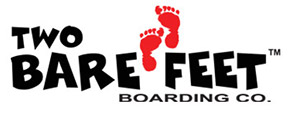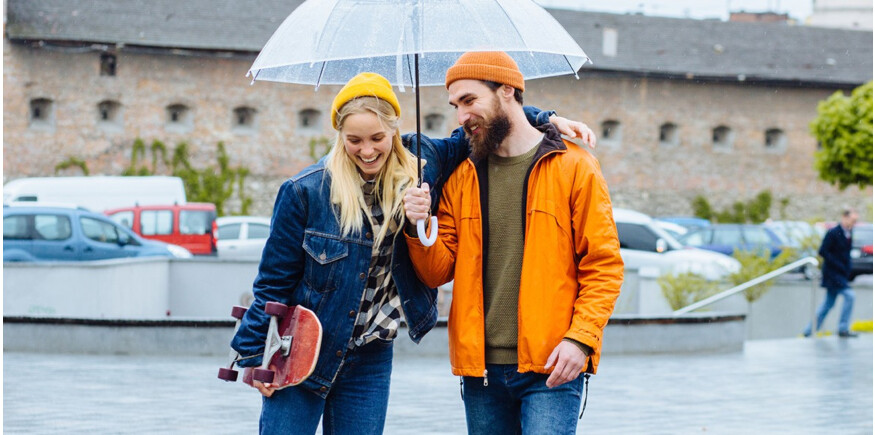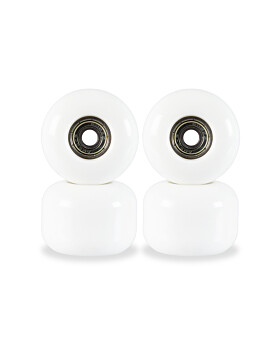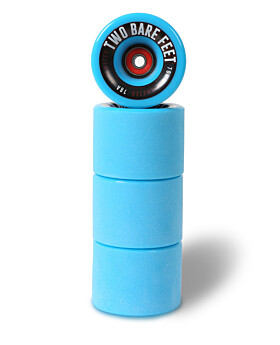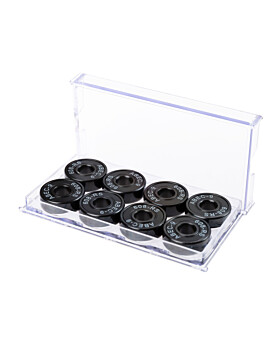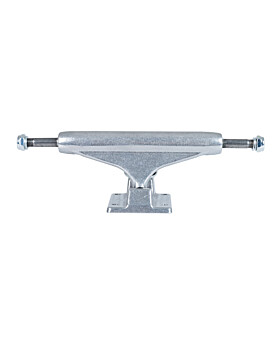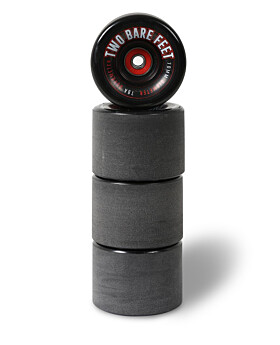Skateboarding is traditionally seen as a dry-weather activity. Depending on where you live, the allure of skateboarding throughout the year may mean navigating a range of seasonal outdoor conditions. This brings up an intriguing question: Is it okay to ride a skateboard in the rain?
Understanding the challenges of wet-weather skateboarding
Many seasoned skateboarders advise against riding in the rain. Why?
Water can significantly reduce the friction between skateboard wheels and the riding surface, affecting grip and stability. The lack of traction makes it harder to brake, turn, and execute tricks safely. In severe conditions, smooth, wet surfaces can also cause the wheels to hydroplane.
Additionally, water can seep into the board’s components, causing damage over time. The wheels, bearings, and trucks can corrode; grip tape can weaken; and a wooden deck is susceptible to become waterlogged, leading to warping and cracking.
The combination of reduced grip, impaired braking, and slippery surfaces significantly elevates the risk of falls and injuries. Even experienced skaters can struggle to maintain balance and control in wet conditions.
Impact on different skateboarding styles
Be it cruising, downhill, or performing tricks at a skatepark – the type of skateboarding you choose to engage in will face its own set of challenges in the rain.
While longboards, with their larger wheels and wider decks, provide more stability, cruising in the rain may result in a slower and less responsive ride. Downhill skateboarding will also be more dangerous, due to the potential for greater momentum coupled with reduced control.
If you’re on a classic double-kick, executing tricks in a skatepark becomes more challenging. Having narrower wheels and a smaller deck already requires a degree of technical competency under typical conditions. Unless you are extremely sure in your abilities, it isn’t advisable.
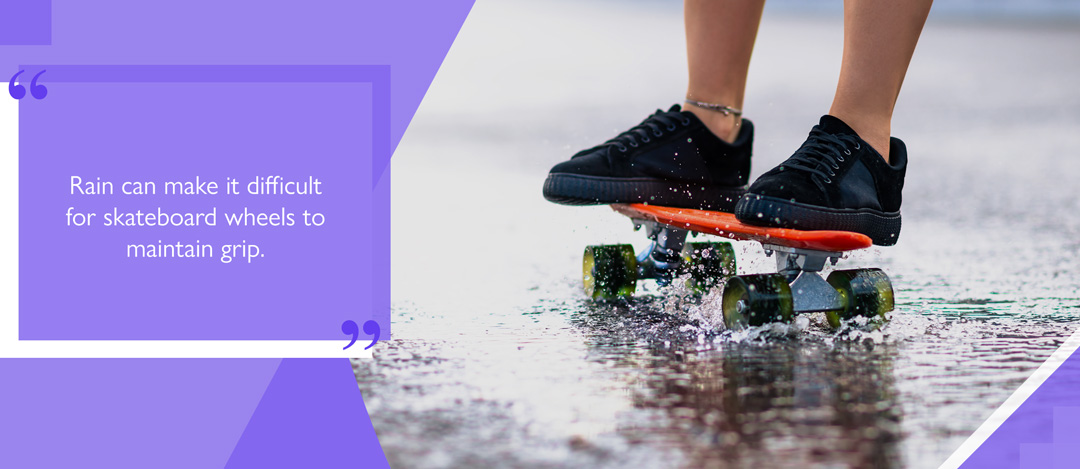

Adapting how you ride your skateboard or longboard
To accommodate the physical differences caused by wet surfaces, a change in the rider’s stance on the board may be necessary. Riders may need to adopt a wider, more balanced position to keep their weight centred, which could be uncomfortable or challenging for beginners.
It also makes sense to adjust your riding style to accommodate reduced grip and braking ability in wet conditions. Ride slowly, make wider turns, and avoid sudden movements. Gentle application of your foot to stop, or carving to slow down, is better than the risks of forceful braking.
Other appropriate considerations when riding in rain include:
- Choosing suitable routes: If you’re cruising or commuting, opt for less crowded streets and paths with minimal obstacles. Where (and if) possible, avoid riding on heavily trafficked roads or areas with poor drainage.
- Wearing appropriate footwear: Wear shoes with good traction and a flat sole to provide better control both on wet surfaces you’ll be pushing off, and a deck that provides reduced friction.
- Being mindful of your surroundings: Steer clear of obstacles, uneven surfaces, parked cars and puddles. Scan the terrain for potential hazards and anticipate the movements of other pedestrians, vehicles, and fellow skateboarders.
- Take to cover: If street skating and grinding rails is your thing, you’re better off finding an environment that is covered, whether this is purpose-built or suitable owing to its design (e.g. an unused carpark). Of course, you must have relevant permission from the owner.
The impact of wet weather on skateboard wheels
The type of wheels your board is equipped with will influence performance. Ultimately, no wheel is immune to some degree of reduced grip caused by water. However, some may fare slightly better than others.
Larger, softer wheels with a durometer rating of 78A-85A, offer better grip, enhancing control and reducing the risk of slipping. Conversely, smaller, harder wheels with a durometer rating of 90A or higher provide less grip, increasing the likelihood of hydroplaning.
Softer wheels achieve better grip on wet surfaces due to their increased flexibility. This allows them to better conform to the imperfections in the surface, creating more surface contact and improving traction.
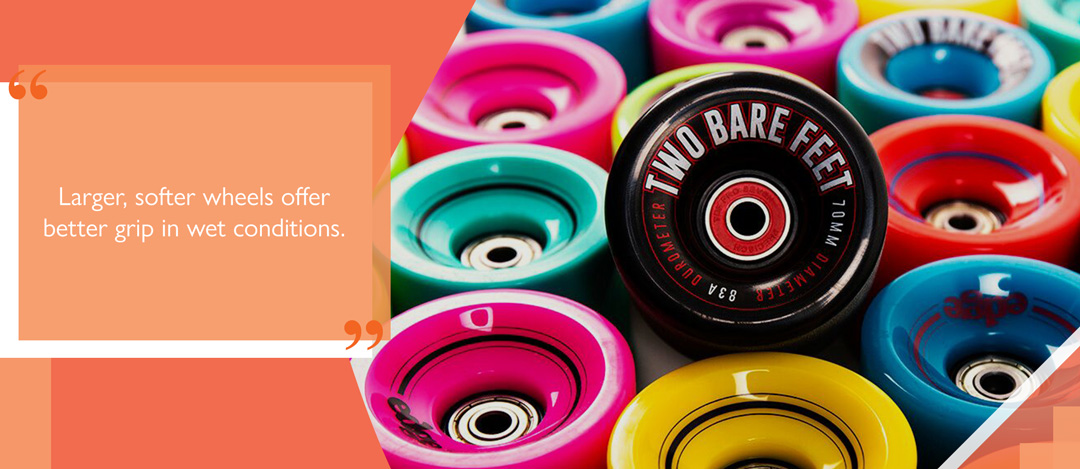

On the other hand, harder (and stiffer) wheels tend to bounce off these imperfections, reducing grip and increasing the risk of skidding.
In addition to durometer, the shape of the wheels also plays a role. Rounder wheels offer better grip on wet surfaces, while squarer wheels tend to hydroplane more easily.
Rounder wheels make more contact with the ground, distributing the rider’s weight more evenly, reducing the likelihood of water pockets forming beneath the wheels.
Skateboard maintenance for wet weather
Proper board care is crucial for ensuring your ride remains in optimal condition and minimizing the risk of damage, especially after riding in wet conditions. Here are some key tips for wet-weather maintenance:
Immediate drying
After your ride, thoroughly wipe down your skateboard with a damp cloth to remove any excess water. If you can, do this with the components unmounted. Avoid leaving the skateboard wet for extended periods, as this can lead to corrosion of metal components and warping of the deck.
Never use a hairdryer or compressed air to dry your skateboard parts; these harsh methods can damage the bearings and grip tape. Stick to using a cloth for gentle and effective drying.
Lubrication for moving parts
Clean and lubricate your bearings, wheels, and trucks. Use a suitable lubricant to reduce friction and maintain optimal performance.
For wheels, a water-based lubricant is recommended to prevent moisture from attracting dirt and grit. For trucks, use a high-quality grease that can withstand moisture and wear. And for bearings, use a lubricant that can reduce friction and protect against rust.
Consider rain-appropriate components
Wheels made from urethane formulations are more resistant to water absorption and have improved grip on wet surfaces. Additionally, waterproof deck protectors and grip tape can help protect your board from moisture damage.
A well-manufactured set of bearings with splash-proof casings can also be a boon for reducing the level of wear and tear caused by water in the long term. However, while bearings and wheels can withstand some water, it isn’t a good idea to leave them exposed in water for prolonged periods.
Is there an ideal setup for skateboarding in rain?
At the end of the day, there is no perfect way to mitigate the effects that rain can have on your board and your riding experience. Considering all the challenges above, skateboarding in wet weather is probably an activity riders of all abilities should avoid, especially beginners.
However, if it can’t be avoided – for example, if your skateboard is your means of commuting to and from school or work – there are certain precautions that you can take to minimise the potential problems caused by rainwater.
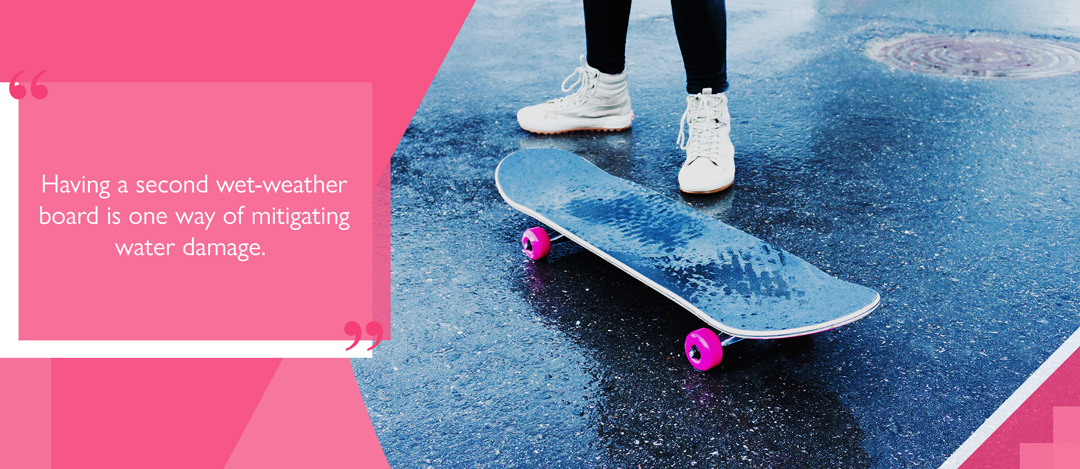

If you can afford it, or have access to older or additional boards, a common piece of advice among seasoned skaters is to just have a second board available, specifically for the rain; preferably one you don’t mind being exposed to possible water damage or are happy to strip apart and adjust.
It’s also important to have good quality protective skateboarding gear. If you are riding in conditions that increase your likelihood of being involved in a fall or collision, it is imperative that you have adjustable safety equipment that will withstand impacts while remaining comfortable to wear.
Two Bare Feet’s skateboard parts and accessories
If you’re looking to ride, come rain or shine, it’s best to be prepared and to invest in quality components.
At Two Bare Feet, we have a range of parts and accessories to upgrade or extend your wet-weather riding experience, whether you’re outfitting an old board for use on rainy days or customising your main one.
Our longboard wheels are polyurethane and made to a 78a durometer rating, meaning they’re impermeable, but soft enough to provide extra grip needed on a slick surface, helping with traction and stability. We also offer 85a classic skateboard wheels if you want extra grip for your double-kick.
If you find yourself needing some fresh components due to water damage or corrosion, then we’ve also got you covered.
Our selection of steel and aluminium trucks are manufactured in three sizes – from 5” to 5.875” to accommodate differing deck sizes. If you need to go fast, our ABEC 9 bearings are splash-proof and easy to install. And if you need replacement bolts, we can help you change them in style!
